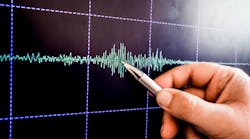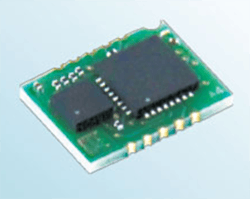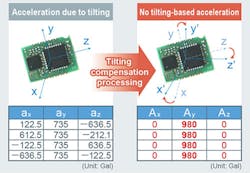Tiny Module is Sophisticated, Precise “Personal” Earthquake Detector
Download this article in PDF format.
When we think of earthquakes and seismic events, we naturally think of relatively large, complex laboratory instruments, and rightfully so. However, there’s also a need for smaller-scale, highly localized earthquake detectors for applications such as triggering of automatic doors, stopping equipment operation, shutting down unmanned transport vehicles, and marking of infrastructure (roads, bridges) with possible earthquake damage.
These units should focus on basic detection and yes/no decision-making with only modest data storage, in contrast to a complex lab unit. The traditional solution to the basic detection problem has been to use a mechanical vibration detector, but this lacks the ability to distinguish basic vibration from a true earthquake and its seismic patterns. The result is either missed events or false positives, both of which are obviously undesirable decisions. False detection can also be initiated due to the complex vibrations caused by collisions with external objects.
However, by performing detailed analysis of vibration waveforms, ROHM Semiconductor's engineers were able embed a suitable algorithm function that distinguishes between waveforms due to external factors’ vibrations and actual seismic events. This led to the development of the BP3901, an ultra-compact, high-accuracy module (11.8 × 8.6 × 2.5 mm) combining a three-axis accelerometer sensor (from ROHM’s Kionix Group) with proprietary earthquake-detection algorithms embedded alongside the sensor (Fig. 1). Among other features, the algorithm includes a function for avoiding false detection, and can accurately distinguish between vibration due to earthquakes versus other external factors.
1. The ROHM BP3901 two-device earthquake-detector module comprises an accelerometer and an analog/digital signal processor executing sophisticated algorithms, resulting in reliable, consistent determination of genuine earthquakes rather than other vibration-driven events.
To transform the potential of the hardware and concept into reality, Rohm’s algorithm focuses on determining “spectrum intensity” (SI). SI values have a high correlation with measured seismic intensity data used for earthquake damage assessment (Fig. 2). It’s a somewhat subjective measurement of the effects of an earthquake on humans, objects of nature, and man-made structures.
2. The algorithms in the BP3901 can distinguish between earthquakes and similar vibration-driven events such as passing of vehicles. (Note the long time scale on the horizontal axis; on the vertical axis, the gal—short for galileo after Galileo Galilei—is a unit of acceleration used extensively in the science of gravimetry, where one gal is defined as 1 cm/sec2.)
It also optimizes the digital signal processing of acceleration data and calculation parameters/sequence through analysis of measured excitation data. Finally, the module includes an angle correction function (±15 deg. allowable mounting angle) that can correct for unintentional tilt of the module, further improving detection accuracy (Fig. 3).
3. The BP3901 combines the characteristics of its built-in accelerometer with a new angle-compensation operation to correct for vertical-plane inclination up to ±15 deg.
These earthquake-sensing applications obviously tend to be “install and forget,” so changing batteries ranges somewhere between a large nuisance to major hassle. Thus, the module is designed to be in standby mode until a seismic event is detected. By optimizing its arithmetic processing, the BP3901 features a standby current consumption of just 3.5 µA. To put this in perspective, an installation having an average of 10 seismic events a month, each with duration 180 sec, could operate for more than five years on just a pair of alkaline AA batteries in series.
For data storage and further analysis, the BP3901 (sampling now, OEM quantities in August 2019) saves calculated seismic data in non-volatile memory when the vibration exceeds a certain level, and the last 16 seismic events can be stored in order of earthquake magnitude. Analyzing earthquake data from various locations may make it possible to better predict future earthquakes, as well as result in further algorithm improvements.




